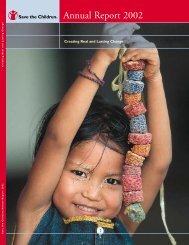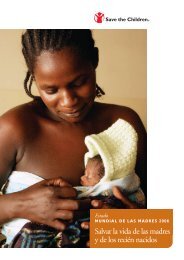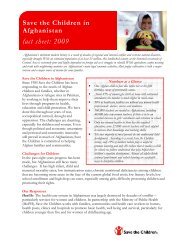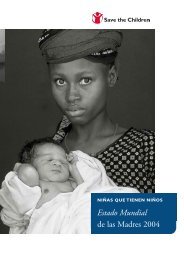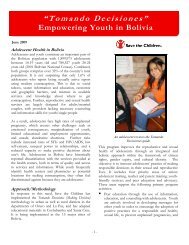The Power and Promise of Girls' Education - Save the Children
The Power and Promise of Girls' Education - Save the Children
The Power and Promise of Girls' Education - Save the Children
Create successful ePaper yourself
Turn your PDF publications into a flip-book with our unique Google optimized e-Paper software.
mo<strong>the</strong>rs, are educated, <strong>the</strong>ir children – both boys <strong>and</strong><br />
girls – have a greater chance <strong>of</strong> going to school <strong>and</strong><br />
doing well <strong>the</strong>re. By investing in girls’ education now,<br />
<strong>the</strong>se countries are helping to ensure that future<br />
generations will receive <strong>the</strong> schooling <strong>the</strong>y deserve.<br />
Case in point – Benin<br />
<strong>The</strong> small West African nation <strong>of</strong> Benin is among <strong>the</strong><br />
world’s poorest countries, yet it allocates almost one<br />
third <strong>of</strong> its central government budget to education – a<br />
higher percentage than any o<strong>the</strong>r African country. 64<br />
In recent years, Benin, with <strong>the</strong> help <strong>of</strong> <strong>the</strong> international<br />
donor community, has been engaged in a sweeping<br />
educational reform with a strong emphasis on education<br />
for girls. Projects were launched to improve <strong>the</strong> quality<br />
<strong>of</strong> basic education through better teacher training,<br />
curriculum reform, textbook distribution <strong>and</strong> heightened<br />
community involvement in education. Mo<strong>the</strong>rs’<br />
associations were introduced to encourage a special<br />
focus on girls’ education <strong>and</strong> equity. School canteens –<br />
supported in part by <strong>the</strong> U.S. Agency for International<br />
Development (USAID) <strong>and</strong> World Food Programme<br />
contributions – were developed to reduce <strong>the</strong><br />
opportunity costs <strong>of</strong> school attendance <strong>and</strong> to ensure<br />
that learning would not be impeded by hunger or<br />
Methodology: <strong>The</strong> following indicators were used to<br />
construct an unweighted index: 10-year gains in percentage<br />
<strong>of</strong> budget spent on education; 10-year gains in female net<br />
enrollment ratios; 10-year gains in overall primary school<br />
completion rates. Countries were <strong>the</strong>n ranked on <strong>the</strong>ir<br />
index scores. Any country with a low index score on any<br />
o<strong>the</strong>r Forecast-related index was discarded.Among<br />
remaining countries, those that had well-documented<br />
programs related to <strong>the</strong> expansion <strong>of</strong> educational<br />
opportunities for all children (<strong>and</strong> for girls in particular)<br />
along with well-documented results for <strong>the</strong>se programs<br />
were highlighted in <strong>the</strong> Forecast.<br />
Rationale: Government spending on education (as a<br />
proportion <strong>of</strong> total budget) is a strong <strong>and</strong> direct measure <strong>of</strong> a<br />
government’s commitment to achieving education for all.<br />
Female net enrollment ratios are a strong indicator <strong>of</strong> whe<strong>the</strong>r<br />
children are starting school on time <strong>and</strong> making satisfactory<br />
academic progress over time. Increases in overall completion<br />
rates are a good indicator <strong>of</strong> future educational dem<strong>and</strong>.<strong>The</strong>re<br />
is a strong relationship between a mo<strong>the</strong>r’s educational<br />
attainment <strong>and</strong> <strong>the</strong> decision to send a child to school.<br />
malnutrition. And <strong>the</strong> Community Action for Girls’<br />
<strong>Education</strong> (CAGE) project – funded by USAID <strong>and</strong><br />
implemented by World Learning – works with<br />
communities in Benin to remove obstacles in households<br />
<strong>and</strong> communities that prevent girls from attending<br />
primary school.<br />
As part <strong>of</strong> Benin’s intensive effort to extend educational<br />
opportunities to all its young citizens, many pilot<br />
projects have been initiated. For example, <strong>Education</strong> <strong>and</strong><br />
Community (EDUCOM) covers approximately 25,000<br />
pupils in 140 schools in 100 villages. This project allows<br />
<strong>the</strong> community, through direct involvement in school life,<br />
to take responsibility for school oversight <strong>and</strong> to<br />
maintain girls in <strong>the</strong> system. Partnership contracts <strong>and</strong><br />
micro-plans emphasizing girls’ education are made<br />
between schools <strong>and</strong> communities. Teachers, parents <strong>and</strong><br />
village council members are engaged in <strong>the</strong> planning<br />
process. Older girls mentor younger girls who are at<br />
risk <strong>of</strong> dropping out. Support is given to training for<br />
teachers on gender sensitivity, to parents’ associations<br />
on school management, <strong>and</strong> to village councils on<br />
increasing female participation. 65<br />
In <strong>the</strong> rural regions <strong>of</strong> Benin, adults earn an average <strong>of</strong><br />
$164 a year. To send one child to primary school for a<br />
year – including fees <strong>and</strong> supplies – costs $24. To lessen<br />
this burden, <strong>the</strong> Beninese government waived primary<br />
school fees for girls. This “scholarship” had a positive<br />
impact on getting girls to school who o<strong>the</strong>rwise would<br />
not have attended. 66<br />
Meanwhile, <strong>the</strong> CAGE initiative is focusing on obstacles<br />
at <strong>the</strong> household <strong>and</strong> community level, such as parents’<br />
expectations for girls (girls are <strong>of</strong>ten expected to marry<br />
at a younger age than boys <strong>and</strong> to carry more<br />
household responsibilities) as well as o<strong>the</strong>r physical<br />
deterrents from regular attendance (distance <strong>of</strong> travel to<br />
28<br />
THE POWER AND PROMISE OF GIRLS’ EDUCATION




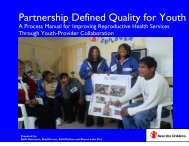

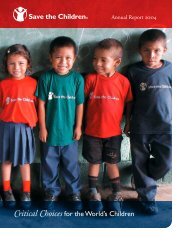
![View full document [PDF 3.39 MB] - PreventionWeb](https://img.yumpu.com/27308954/1/190x245/view-full-document-pdf-339-mb-preventionweb.jpg?quality=85)
